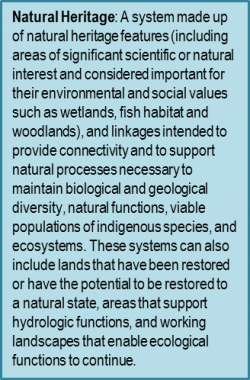June 16, 2014
Assessing Climate Change Risks to Natural Heritage Systems in the Region of Peel
 Climate change is anticipated to impact not only built infrastructure, for example roads, bridges, and electrical transformers, but also key components of natural heritage systems. The Region of Peel and its partners released its Climate Change Strategy in 2011 with key recommendations for: Reducing Vulnerability, Limiting Greenhouse Gases, and Strengthening Partnership. (Region of Peel, 2011). A key of the Strategy was to “complete a vulnerability and risk assessment of all infrastructures, of the community and of natural heritage.” Building upon initial work focused on climate change vulnerability and risk assessment in Port Credit and Caledon, Toronto and Region Conservation Authority (TRCA), in partnership with the Region of Peel, Credit Valley Conservation (CVC), Ministry of Natural Resources (MNR), Ontario Centre for Climate Impact and Adaptation Resources (OCCIAR), and Ontario Climate Consortium (OCC) , is currently undertaking an assessment of the vulnerability of the natural heritage system to climate change within Peel Region.
Climate change is anticipated to impact not only built infrastructure, for example roads, bridges, and electrical transformers, but also key components of natural heritage systems. The Region of Peel and its partners released its Climate Change Strategy in 2011 with key recommendations for: Reducing Vulnerability, Limiting Greenhouse Gases, and Strengthening Partnership. (Region of Peel, 2011). A key of the Strategy was to “complete a vulnerability and risk assessment of all infrastructures, of the community and of natural heritage.” Building upon initial work focused on climate change vulnerability and risk assessment in Port Credit and Caledon, Toronto and Region Conservation Authority (TRCA), in partnership with the Region of Peel, Credit Valley Conservation (CVC), Ministry of Natural Resources (MNR), Ontario Centre for Climate Impact and Adaptation Resources (OCCIAR), and Ontario Climate Consortium (OCC) , is currently undertaking an assessment of the vulnerability of the natural heritage system to climate change within Peel Region.
In the fall of 2013, TRCA hosted stakeholders from throughout the region as part of an engagement workshop to better understand how the natural environment is viewed and valued by capturing the importance of ecosystems, their components and the services they provide to people who work and live in Peel Region. Ecosystem services are broadly defined as the benefits that people obtain from ecosystems, such as water quality regulation, clean water for drinking or irrigation and recreational benefits (MEA, 2005; Landers & Nahlik, 2013). From this consultation, together with guidance provided by the partnership, emerged the proposed scope of a Vulnerability and Risk Assessment on the Natural Heritage System in Peel Region.
The scope of this project includes examining relevant components of Peel’s natural heritage at a watershed/regional scale, such as rivers and streams, groundwater systems, urban and natural forests and wetlands; identifying important ecosystem services produced by each component; and then estimating component vulnerability based on the potential impacts due to climate change. It is assumed that ecosystem service delivery would change if impacts to the natural heritage components occur.
On May 8 of 2014, TRCA hosted a second workshop to facilitate a technical discussion surrounding the research framework for the project. Representatives from the Region of Peel, the Ontario Ministry of Natural Resources, Mississauga’s Credit Valley Conservation, and the Ontario Centre for Climate Impacts and Adaptation Resources (OCCIAR) were present to provide valuable input. Workshop participants had the opportunity to hear presentations regarding the broader project context from the Region of Peel, the refined project scope and objectives outlined by the project manager, and directions and ideas for the vulnerability assessment from OCCIAR. Using input from subject matter experts, municipal stakeholders and partners (which recently broadened to include the University of Waterloo),research is now underway to better understand climate impacts for natural heritage components within Peel Region.
Expected outcomes from this project (Phase 1) include a relative vulnerability and risk distribution of natural heritage components in Peel Region presented through spatial mapping, as well as a detailed technical report qualifying vulnerability levels and risks on ecosystem services associated with climate change. Ultimately, technical findings will be translated in policy ready information and the development of recommendations to reduce vulnerability, protect, and adapt Peel Region’s natural heritage to climate change (Phase 2).
References
Landers, D., Nahlik, A. 2013. Final Ecosystem Goods and Services Classification System (FEGS-CS). Corvallis, Oregon: United States Environmental Protection Agency (US EPA), Office of Research and Development, National Health and Environmental Effects Research Laboratory, Western Ecology Division.
Millennium Ecosystem Assessment. 2005. Ecosystems and Human Well-being: Synthesis. Island Press, Washington, DC.
Region of Peel. 2011. Peel Climate Change Strategy – A Strategic Plan for Climate Change for the Geographic Region of Peel. Available online: www.peelregion.ca/climatechange
 Glenn Milner is an environmental engineer specializing in water resources. He is currently a graduate student at the University of Waterloo pursuing a master’s degree in climate change and is an Mitacs intern with the Toronto and Region Conservation Authority (TRCA) and Ontario Climate Consortium (OCC) . His research interests lie in harnessing co-benefits from climate change mitigation, adaptation and the sustainable growth of infrastructure.
Glenn Milner is an environmental engineer specializing in water resources. He is currently a graduate student at the University of Waterloo pursuing a master’s degree in climate change and is an Mitacs intern with the Toronto and Region Conservation Authority (TRCA) and Ontario Climate Consortium (OCC) . His research interests lie in harnessing co-benefits from climate change mitigation, adaptation and the sustainable growth of infrastructure.




Comments are closed here.